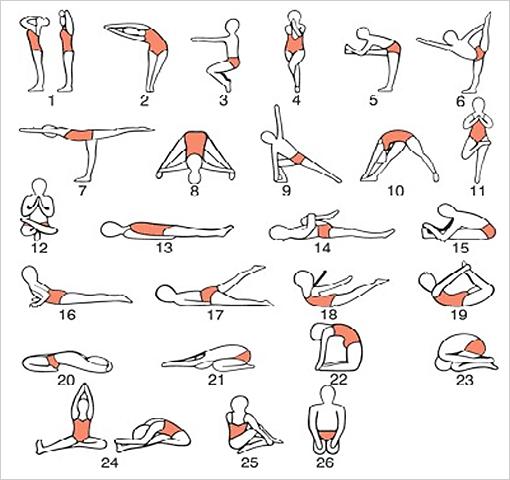The Bikram Yoga Poses
The Bikram Yoga Poses
Bikram Yoga, in essence is a series of 26 postures, known as ‘Asana’, and 2 breathing exercises done in the same order for the duration of 90 minutes.The first 12 postures make up the ‘standing series’. In order, to fully prepare the body for the standing series, it is important to practice ‘Pranayama’- or ‘Standing Deep Breathing’ as part of the series. This oxygenates the body, filling the lungs and readying you for the first of the standing postures.Poses 13 to 26 are known as the ‘floor series’. Carried out whilst sitting or kneeling, these postures take into account the stress placed on the body during the first hour of class and are separated by what is referred to as ‘Savasana’- ‘Corpse Pose’ or ‘Dead Body Pose’. In Savasana, you are encouraged to rest and restore your body in anticipation of the next pose. Savasana, whilst it looks to be the simplest of the postures, it is often referred to as the most difficult pose to fully master as it requires complete and utter relaxation of the body, and the mind.
Below is the list of 26 Bikram yoga postures and their benefits.

-
Pranayama / Standing Deep Breathing
Helps prevent respiratory problems such as bronchitis, emphysema and shortness of breath.
-
Half Moon Pose / Ardha-Chandrasana
Half Moon Pose strengthens every muscle in the body’s core, especially in the abdomen, and flexes and strengthens the latissimus dorsi, oblique, deltoid and trapezious muscles. It increases the flexibility of the spine comprehensively from coccyx to neck, promotes proper kidney function and helps to cure enlargement of the liver and spleen. Half Moon also firms and trims the waistline, hips, abdomen, buttocks and thighs.
-
Hands to Feet / Pada-Hasthasana
Hands to Feet Pose stretches the spine and increases flexibility, as does Half Moon. Both poses firm and trim the lower body where many problem areas (especially for women) reside. Hands to Feet Pose works the muscles, ligaments and tendons of the legs and improves circulation there as well.
-
Awkward Pose / Utkatasana
Awkward Pose will tone and shape your legs.
It heals chronically cold feet.
It also helps relieve rheumatism and arthritis in the legs and helps to cure slipped discs and other problems in the lower spine. -
Eagle Pose / Garurasana
Eagle is the only posture that opens up the 14 largest joints in the skeletal system.
Beyond improving flexibilities in the hips, knees, ankles and the rest, Eagle Pose also supplies fresh blood to the reproductive system and sex organs, plus the kidneys, which increases sexual vitality and helps clear up reproductive problems. -
Standing Head to Knee / Dandayamana-Janushirasana
This posture improves the flexibility of the sciatic nerves and strengthens the hamstrings and leg muscles.
It also works the muscles of the back, the biceps and the triceps. It helps to squeeze and flush out the internal abdominal organs, such as the gall bladder, pancreas and spleen, as well as the uterus and ovaries. -
Standing Bow Pose / Dandayamana-Dhanurasana
Standing Bow moves all the blood from one side of the body to the other, then back again. It develops balance, increases the size and elasticity of the rib cage, firms the abdominal wall and upper thighs.
It improves the flexibility and strength of the lower spine. Standing Bow builds patience, determination and concentration. -
Balancing Stick / Tuladandasana
The forward tilt of your torso sends high-speed blood pouring into the heart, especially the neglected region, cleaning out the veins and all the arteries, strengthening the heart muscle. The same rejuvenating flood rushes into the brain as well. It strengthens your powers of concentration.
-
Standing Separate Leg Stretching Pose / Dandayamana-Bibhaktapada-Paschimotthanasana
This posture is like kryptonite for sciatica! That’s because it stretches and strengthens those poor crushed and shriveled sciatic nerves, as well as all the tendons in the legs. It also massages the internal abdominal organs and the small and large intestines, and gives you added flexibility in the pelvis, ankles, hip joints and specially in the last five vertebrae of the spine.
-
Triangle Pose / Trikanasana
It improves every single bone, muscle, joint, tendon and internal organ, and it revitalizes nerves, veins and tissues. Flexing and strengthening the last five vertebrae in this posture can alleviate crooked spines, as well as rheumatism and lower back pain. Triangle Pose also benefits the heart and lungs, forcing them to work together.
-
Standing Separate Leg Head to Knee Pose / Dandayamana-Bibhaktapada-Janushirasana
Standing Separate Leg Head to Knee Pose trims the abdomen, waistline, hips, buttocks and thighs. It massages and compresses the thyroid gland, which helps to regulate the metabolism and the immune system.
-
Tree Pose / Tadasana
The Tree Pose improves posture and balance and increases the flexibility of the ankles and knees as well as the hip joints. By strengthening the internal oblique muscles, it prevents hernia.
-
Toe Stand / Padangustasana
Toe Stand strengthens the knees and is therapeutic for rheumatism of the knees, ankles, and feet.
It also opens up the knee and hip joints, and helps cure hemorrhoid problems. It also develops mental strength. -
Dead Body Pose / Savasana
Dead Body Pose facilitates powerful blood flow, then lets circulation return to normal, creating internal cleansing and greatly magnifying the benefits of the postures that precede it. It teaches relaxation.
-
Wind-Removing Pose / Pavanamuktasana
Wind-Removing Pose compresses and massages the ascending colon and descending colon. It also massages the transverse colon and compresses the entire digestive system. It strengthens the arms, prevents flatulence, improves hip flexibility, and firms the abdomen and thighs.
-
Cobra Pose / Bhujangasana
Cobra Pose strengthens the lumbar spine, relieving pain and combating slipped or herniated discs, scoliosis and arthritis in that region. Other important benefits include improved digestion, relief from menstrual disorders, improved appetite, and raising low blood pressure. Cobra Pose also improves the functioning of the liver and spleen.
-
Locust Pose / Salabhasana
Locust Pose has many of the same benefits as Cobra, but it is even better for slipped discs and sciatica.
It strengthens the upper spine, and the uncomfortable stretching of the arms can actually relieve tennis elbow.
Locust can also help with varicose veins in the legs. -
Full Locust Pose / Poorna-Salabhasana
Full Locust increases strength in the middle spine; it is good for scoliosis, kyphosis, spondylosis and slipped discs. It opens up the rib cage and increases elasticity there. It also firms the abdominal muscles, upper arms, hips and thighs.
-
Bow Pose / Dhanurasana
Bow Pose opens up the rib cage, which allows the lungs to expand more fully. This 360-degree flexion of the spine revitalizes all the spinal nerves by increasing circulation, and strengthens the spine along its entire length. Besides helping with all manner of back problems, Bow Pose aids digestion, fights constipation, and combats bronchitis and diabetes while improving the functioning of the large and small intestines, the liver, kidneys and spleen.
-
Fixed Firm Pose / Supta-Vajrasana
Fixed Firm Pose strengthens and improves the flexibility of the lower spine, hips, knees and ankle joints.
It increases circulation to the lower limbs, and is therapeutic for lower back pain, sciatica, rheumatism and varicose veins. It helps prevent hernias. -
Half Tortoise Pose / Ardha-Kurmasana
Half Tortoise Pose can actually help us to live longer. Tortoise is great for tense necks and shoulders. It also increases blood flow to the brain, which enhances memory and mental clarity. This posture also stretches the lower part of the lungs, which is therapeutic for asthma and counter indigestion, flatulence, constipation and irritable bowel syndrome.
-
Camel Pose / Ustrasana
Camel Pose creates maximum compression of the spine, which stimulates the nervous system.
It also improves flexibility of the neck and spine, relieves backache, and helps degenerative spinal problems such as kyphoscoliotic deformities and cervical spondylosis. By stretching the abdominal organs, Camel helps constipation and it also stretches the throat and thyroid and parathyroid glands. -
Rabbit Pose / Sasangasana
Maximum extension of the spine increases its mobility and elasticity, and does the same for the back muscles.
Stretching the spine also expedites the feeding of the nervous system with fresh blood and oxygen.
Rabbit Pose relieves tension in the neck, shoulders and back. It helps alleviate colds, sinus problems, and chronic tonsillitis and through compression of thyroid and parathyroid, rejuvenates those glands as well.
Rabbit Pose can also be therapeutic for insomnia, diabetes and depression. -
Head to Knee Pose and Stretching Pose / Janushirasana and Paschimotthanasana
It is excellent for the immune and lymphatic systems, increases circulation to the liver, pancreas, thyroid, thymus and intestines. It improves digestion and is good for allergies and arthritis. It also relieves chronic diarrhea by improving the circulation in the bowels.
-
Spine-Twisting Pose / Ardha-Matsyendrasana
This is the only posture that twists the spine from top to bottom, which increases circulation to all the spinal nerves, veins, and tissues, and improves the elasticity of the spine. Spine Twisting relieves lower back pain and helps prevent slipped discs, rheumatism of the spine, kyphosis, scoliosis, cervical spondylosis and arthritis. It also calms the nervous system.
-
Blowing in Firm Pose / Kapalbhati in Vajrasana
It improves digestion and circulation, and increases the elasticity of the lungs with every forceful exhale.
You generate prana, and push out every ounce of carbon dioxide, replacing it with life-giving oxygen.
It also strengthens the abdominal organs and increases circulation to them. Blowing in Firm stimulates the digestive system as well.Information sourced from the Bikram Hot Yoga official website
www.bikramyoga.com



